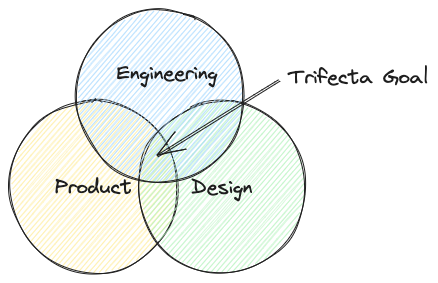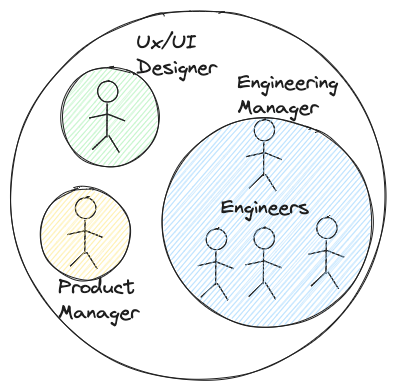The Trifecta model (or a Triad) is a group of three leaders who share a goal and have clear accountability and autonomy to deliver a valuable, feasible, usable product.
The Trifecta Goal

The Trifecta goal is to build a product that is:
- Valuable for customers
- Feasible to build (technology, security, etc.)
- Usable for the end users
To achieve such a goal, you need a cross-functional product team with the required skills and full autonomy to discover, design, deliver and operate the product at scale. The trifecta group includes a product manager, a UX/UI Designer and an engineering manager who leads the engineering team.

The three roles mentioned above have the following responsibilities throughout the product development life cycle.
Product Manager (Valuable)
A product manager is accountable for determining what and why we prioritise solving a particular problem that provides high value to customers. This can be through building a new product, implementing or improving an existing feature. Product managers are responsible for product discovery, seek customer validation, and interview clients to understand their needs. This role should also collaborate with external teams, such as sales or marketing, to understand the product’s position in the market.
Engineering Manager (Feasible)
The engineering manager is accountable for how to deliver the technical solution and when it will be ready. Engineering managers define the processes on how the team should operate (planning, delivery, etc.), collaborate with the engineers on the implementation (technical design, architecture, testing and observability) and empowers the team to deliver value. I have written a detailed article demystifying the the engineering manager role.
UX/UI Designer (Usable)
The UX/UI designer is accountable for ensuring the best user experience when using the product. This role is responsible for user research, prototyping and accessibility and usability testing.
Why the Trifecta model?
Adopting the Trifecta model in an organisation is crucial for building impactful products. When product, engineering and design collaborate towards the same goal, each role can collectively provide expertise to deliver the best-in-class product.
Team Alignment
The product team (product, engineering, design) makes decisions collaboratively to ensure everyone is aligned on the same goal and solving the right problems. Such alignment is vital for effective communication, internal and external to the team. The team focuses on the same goal, ensuring the engineers build the most valuable thing for the customers with the best user experience.
Accountability
The Trifecta model clarifies who is accountable for each function, which avoids waste, reduces confusion and increases efficiency. This model encourages shared ownership since all functions shape the product or feature outcome.
Iteration Speed
All parties collaborate closely as a single unity autonomously, allowing quick iterations based on user feedback and business strategy. This agile flexibility to change and adapt quickly can be a key factor in delivering high-quality products in a competitive market.
Better Outcomes
During the product’s life cycle, all parties can contribute with their expertise and insights, which contributes to building more innovative solutions, spark new ideas and improve the final product. Since all the parties are involved in the process, it reduces the risk of missing critical factors that could affect the product’s success and guarantees high quality.
In conclusion, the Trifecta model helps product teams perform more efficiently while delivering customer value. The close collaboration between product, engineering and design is crucial for the success of any product since it enables teams to be aligned and accountable during the product’s life cycle.
- Product - responsible for ensuring the team builds a valuable product for customers.
- Engineering - responsible for the development life cycle and delivery of the product.
- Design - responsible for designing a usable product with a user-friendly experience.